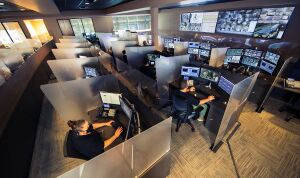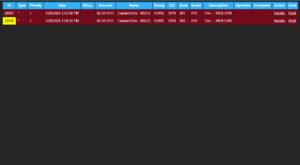Alarm Monitoring Center


An Alarm Monitoring Center (also known as a central station) is a facility that receives signals from alarm panels (including but not limited to alarms, supervisory, and troubles) and will notify the customer and notify the appropriate local authorities (such as Police, Fire, and EMS) if necessary for alarm signals. The equipment of the station always includes computers which can be used to pull up customer information and details, view reports from the panels, and used to control the users systems upon request on compatible panels, the receivers which work as decoders, converting the reporting signals from the panels into text that the operator can understand, and desk phones which are used to call the authorities and the customers. Central stations may have other types of equipment like wall mounted monitors to fit their needs.
Receivers
The receivers in a central station work like a decoder. The alarm signals from the panels which contain the account number, the event type, and even zone numbers and names (if the reporting format allows for it), are encoded at the panel, then is sent to the central station over IP (Ethernet and/or GSM), or most commonly over the phone line (PSTN). There is also the ability to monitor panels over special radios such as over AESNet, but these work a bit differently and are only most common in more rural areas in buildings that don't have any phone lines anymore, but don't have strong cellular coverage. The receiver then decodes this signal into text which the operator can understand. There are different reporting formats. Some companies like Bosch and DMP have their own proprietary format, but their are many industry standard formats, such as Contact ID, Pulse, and SIA. Contact ID is a more modern format which can show which point/zone has activated exactly, but many other formats are capable of doing this too. In a modern central station, the receivers are connected to alarm monitoring software such as SIMSLink, which allows each operator to view events from their computer, then they can "hold the event" which tells the other operators that someone else is already taking care of the event, then they can "handle the event" which lets them clear the event, it will prompt them to make a note of what happened in response to this event/what it was caused by.
Procedures
As soon as an alarm comes to the monitoring center, depending on whether they have dispatch for that customer, they will call the appropriate authorizes, for burglar alarm and residential fire alarm, the customer is always called first and if they don't respond or confirm the emergency, they will dispatch the appropriate authorizes, for commercial fire alarm systems, they will dispatch the appropriate authorizes before calling the customer. If a cancel signal is received from the system, most centers, they will not dispatch appropriate authorizes. If they call the customer and they say it's a false alarm, they will usually ask for a customer known password, and if they don't give them the correct password, they will still dispatch the appropriate authorizes.
Each monitoring center has the ability to put their customers on test, which means they will not dispatch the appropriate authorizes if the alarm goes off, this mode is usually used by the customer before every fire drill and system test. It's important to note that while the Fire Drill signal sent from the panels fire drill button is usually a trouble signal and not a fire alarm signal, some monitoring centers have a policy where they still dispatch the fire department to a fire drill button signal.
When a trouble/supervisory signal is received, they will usually only call the customer to notify them of the event, but some customers may request that for certain events like sprinkler tampers, that certain service like guard service be dispatched to check the system.
If a system is not commutating for a certain amount of time, the center has the ability to see that the panel is not reporting then notify the customer that their system is not working properly. Each system is supposed to send a test report on a regular basis, usually 24-48 hours. This supervision feature is an paid add-on for burglar alarm systems, but is required for commercial Fire Alarm Systems.
Some monitoring companies don't just offer phone call notifications for event notifications, some have mobile apps, web interfaces, and SMS/Email notifications available.
UL Listing
Monitoring companies that meet UL's performance testing for quick response can be UL listed, usually monitoring centers that dispatch authorizes in the US are usually required to be UL listed for Fire Dispatch. This means some alarm monitoring companies can get their start as burglar alarm companies, and work to have fast dispatch times so they can have Commercial Fire Alarm customers.
Hobby monitoring station's
There are a few monitoring stations that alarm enthusiast's can use which lets them see when their hobby system has gone off and view the event history and learn about how alarm monitoring work, these stations are not UL Listed and can't be used for actual dispatch. [1] These station's don't have operators and are fully automated.

